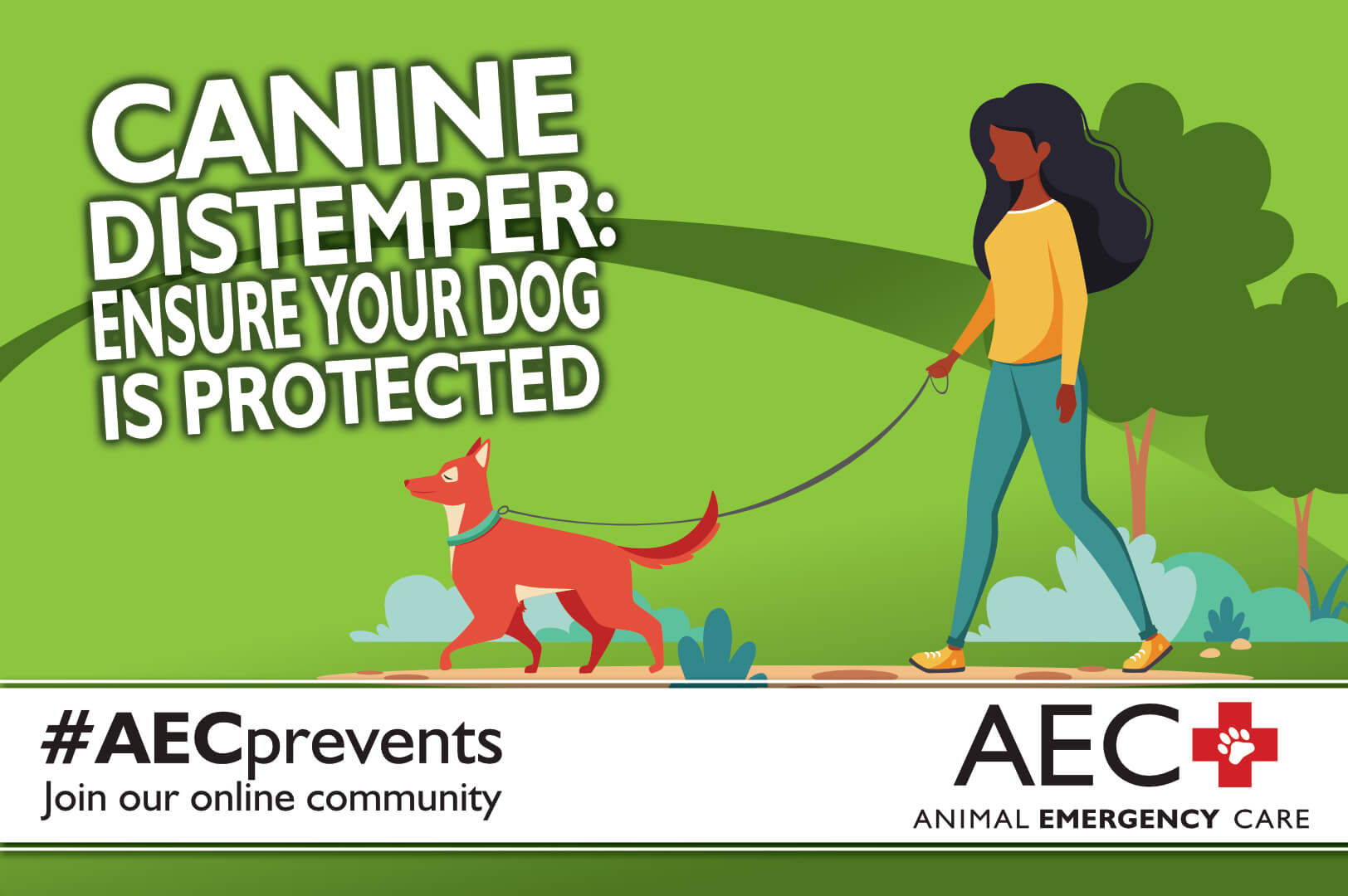During your yearly or more frequent visits with your family veterinarian, your canine companion likely received their core vaccinations and boosters. Core vaccines are defined by the AVMA as those that “protect from diseases endemic to a region, have potential public health significance, are required by law, are virulent/highly infectious, and/or pose a risk of severe disease.” The few first months of your dog’s life are especially critical to ensure their immune system is strong so that common infectious diseases can be prevented. Continuing to vaccinate your pet throughout their life to ensure they are protected from potentially deadly infections and viruses is also critical.
Canine distemper virus (CDV) is part of the core dog vaccinations. Puppies and adult dogs who are not vaccinated are at risk for this potentially deadly virus, and dogs who recover from CDV will have lifelong neurologic problems. Our Animal Emergency Care team wants to ensure your dog is protected from this dangerous disease. We discuss CDV signs, treatment, and prevention.
What is canine distemper virus in dogs?
CDV is a highly contagious paramyxovirus that affects dogs and wildlife including raccoons, skunks, grey foxes, and ferrets. This virus is closely related to the human measles virus, and can lead to respiratory, gastrointestinal (GI), and central nervous system (CNS) problems. CDV is often confused with other infectious diseases, including rabies, because the organ systems affected and clinical signs are similar.
CDV is primarily spread through exposure to sneeze or cough droplets from infected animals, but can also be transmitted through contact with other bodily fluids including urine, blood, or saliva. Dogs of any age can become infected with CDV, and puppies less than 4 months old and unvaccinated dogs are most at risk. Common ways a dog may become infected with CDV include:
- Direct contact with an infected dog
- Exposure to infected wildlife
- A puppy who is born to an infected mother
- Sharing food and water bowls with an infected dog
- Contact with contaminated environments or objects, including bedding or grooming tools
Canine distemper virus signs in dogs
CDV signs are similar to other common dog infectious diseases, and severity will depend on the infected dog’s immune system. Signs may not be visible for more than 14 days after the initial infection, and some dogs may experience mild signs that resolve in 10 days. Additionally, infected dogs may shed this virus for more than six months. Initial CDV signs may include:
- Eye and nasal discharge
- Fever
- Lethargy
- Sneezing and coughing
- Difficulty breathing
- Loss of appetite
- Generalized pain
- Vomiting and diarrhea
- Skin sores
- Thickening of the nose and foot pads
Neurologic signs may develop later in the course of a CDV infection, and may include:
- Muscle twitching
- Head tilt
- Excessive saliva
- Involuntary eye movements
- Jaw tremors or gum-chewing fits
- Balance problems
- Limb weakness
- Paralysis
- Seizures
Canine distemper virus diagnosis and treatment in dogs
Your dog needs a veterinary examination if they are showing CDV signs. Diagnosis is based on your dog’s medical history, clinical signs, and potential CDV exposure history. A PCR test to look for viral particles in samples of an infected dog’s saliva, discharge, or urine will provide a definitive diagnosis. Blood or spinal fluid testing may also be recommended to check for CDV antibodies. Other diagnostic tests may include a complete blood count to check for secondary infections or an associated disease, and a serum biochemistry test to evaluate organ function. Advanced imaging such as an X-ray, computed tomography (CT), or magnetic resonance imaging (MRI), may be recommended for dogs with breathing or neurologic problems.
A CDV infection has no cure. Dogs who receive immediate veterinary care may recover, but may have lifelong neurologic problems. Dogs with severe signs will need hospitalization for supportive care. Treatment may include:
- Intravenous fluids to prevent dehydration
- Oxygen therapy
- Antibiotics to prevent secondary bacterial infections
- Antiviral medications
- Anti-nausea medications
- GI protectants
- Anti-inflammatory medications
- Anti-seizure medications
- Pain relievers
- Specialized diet
Financial options for your dog’s canine distemper virus treatment
CDV treatment may require long-term hospitalization for your pet, plus lifelong veterinary management for neurologic problems. Such long-term care can result in a large veterinary bill. Fortunately multiple payment options are available to ensure you can cover the cost of your pet’s CDV emergency treatment and follow-up care. Pet health insurance providers such as Trupanion offer policies that can pay your veterinary clinic directly, which eliminates the need to submit paperwork and wait for reimbursements. Care Credit and Scratch Pay allow you to spread payments over longer periods with delayed interest rates in some cases. Pet health savings accounts and short-term loans are also available to ensure your pet’s veterinary treatment costs are covered.
Canine distemper virus prevention in dogs
A CDV diagnosis can be devastating for pet owners, because some pets will not recover and many will have lifelong medical problems. Fortunately, widespread vaccination efforts have greatly reduced the numbers of infected dogs. The CDV vaccine is part of a core canine combination vaccination. Puppies should receive their first CDV vaccination at 6 weeks of age, followed by booster vaccinations every three to four weeks until they are 16 weeks old. Ensure your dog does not socialize with other pets or visit dog parks, until they are fully vaccinated. Additionally, prevent your dog from interacting with any wildlife.
Ensure your dog is vaccinated by your family veterinarian to prevent a CDV infection. However, call Animal Emergency Care if your dog has any CDV signs after hours, and bring them in for immediate care. #AECprevents
Sources:
https://veterinarypartner.vin.com/default.aspx?pid=19239&id=4952099
https://www.avma.org/resources/pet-owners/petcare/canine-distemper
https://pets.webmd.com/dogs/canine-distemper#2
https://www.merckvetmanual.com/generalized-conditions/canine-distemper/canine-distemper-overview


